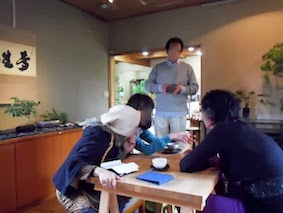Jike Hometown Village / 寺家ふるさと村 -- Part 3
We continue a series on this educational farming village in rural Kanagawa.
In the previous post, I posted photos from inside the sumi house. The staff there had a large display of various tools used in the Japanese tea ceremony; today, I'll showcase some of the lovely ikebana (traditional Japanese flower arrangements), which had been planted inside carved out sections of sumi. They were so unique; I have never seen anything similar.
Every plant was for sale, and the prices were reasonable (from ¥2,000/ $20).
Inside the lecture room, a row of ikebana:
Close up of a stone garden and ikebana:
A single arrangement; my personal favorite:
Before the lecture on sumi was to begin, we were served tea:
The speaker talks about sumi, its history, how it is made, the uses, and names of various parts:
I listened to the approximately 45 minute lecture in Japanese. While some parts were difficult to understand (especially the history), I could understand most. Here were some interesting points:
- Mainlyくなぎ[kunagi] trees are used to make charcoal. In English, Sawtooth Oak.
- In Europe, charcoal comes from Egypt. In Asia, it's made in some areas of China and Japan.
- When burning to the wood to make the charcoal, you need to keep the temperature at a certain level. Too high and the wood turns into a fossil.
- Many believe while burning, wood changes into charcoal from the bottom, up. This is false. The Sumi is actually created from the inside, out.
Sumi has various uses. Here are some examples of how charcoal is used in Japan:
- Used in the rice cooker, a piece of charcoal makes the rice more delicious.
- Used in a pet bottle of water, sumi cleans the water, creating "natural mineral water".
- Used in the home, it filters the air and decreases smells. (use in the refrigerator)
- Crushed sumi filled in a pillow allows users to sleep well.
You can also make sumi at home in your kitchen. Wrapping wooden chopsticks in layers of tinfoil, cooking those over the stove for an hour, will turn the wood into charcoal. A lady in the group showed us examples and handed out information sheets on the process. I'll try someday soon. ^_^
Japanese garden behind the sumi house:
Another view of the garden:
Here is an example of sumi's many uses -- in a fish bowl:
 |
| The water was so clean & the fish looked very happy. I really liked this. |
After the lecture, I asked the guest speaker if charcoal could be used in the soil near Fukushima, to clean out the radiation? Unfortunately, sumi is not strong enough to do such a task. My idea was merely wishful thinking, he said.
Soon, we left the sumi house to go for lunch. The president of the club had booked a unique restaurant hidden in the forest. I'll share photos from that tomorrow.
~Information~
Sumi house is located in Jike Furusato Mura (Hometown Village) near Aoba-dai station in Kanagawa.
Access:
-- Take the Den-en-Toshi line to Aoba-dai station.
-- Change to bus #30 or #31. Get off at "Shiki no Ie".
-- Walk 220 meters to the village. Sumi house is not far from the main information center at the village.
Lectures on sumi can be enjoyed at the village. Reservations required. Click HERE to read more.










Comments
Post a Comment